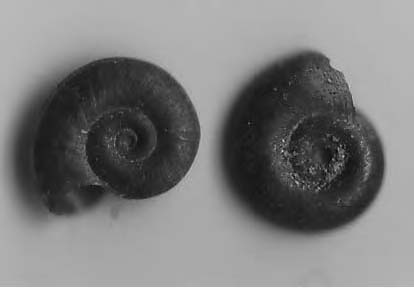|
Pembrokeshire (VC45) lies on the western coast of south Wales and has an extremely oceanic climate. Much of the north of the county is underlain by ancient acidic shales and volcanic rocks, whereas younger sandstones and limestones occur in the south. The Western Cleddau is a soft-water river, rising barely a mile and a half from the sea in North West Pembrokeshire but follows a winding course south eastwards for some 17 miles to reach tidal water at Haverfordwest. North of Haverfordwest the river occupies a wide floodplain. In this stretch of the river there are pools and riffles as well as some large meanders where extensive gravel shoals form. It was here that shells of Planorbis carinatus were first found in November 2006. Previously the most westerly records of Planorbis carinatus in Wales were from the Llanelli area in east Carmarthenshire. Empty shells of P. carinatus were initially found downstream from St Catherines Bridge, near Haverfordwest in Pembrokeshire (SM9428619502) as a result of hand searching among river flood detritus on gravel shoals on November 18th 2006. This site is at least 60 km (in a direct line) west of any previous records for the species. Initial field examination suggested that the shells were those of P. carinatus. The shells were then examined using a binocular microscope and were identified as P. carinatus. M.D. Sutton examined the shells and concurred with this identification. The Atlas of the land & freshwater molluscs of Britain & Ireland was consulted1 and it appeared that the species had not previously been recorded from Pembrokeshire. The Conchological Society was notified of the find and a specimen sent for determination by Adrian Norris who confirmed both the identification and fact that this was indeed a new species for the county. Subsequent searches along this stretch of river found numerous adult and juvenile animals present under stones along the river channel edge. Other gastropod associates included Physa fontinalis, Succinea/Oxyloma spp. and Ancylus fluviatilis. Further searches at a number of points along this river showed that whilst the species occurs elsewhere it appears to be largely restricted to those sections of the river that are not densely shaded by trees and may have a rather restricted distribution. The Eastern Cleddau River which meets the Western Cleddau in its tidal reaches has not yet been searched. It seems quite likely that P. carinatus could occur here too. Some of the small tributaries feeding the Western Cleddau as well as a number of other small brooks were also searched but no further specimens of P. carinatus were found. Despite the failure to find P. carinatus in any of these smaller streams it is perfectly possible that the species may be present and that future searches may locate the species in at least some of them. The finding of a relatively large species of freshwater snail in a well monitored SAC river well beyond its recorded range should give encouragement to the expectation that P. carinatus may be found elsewhere in Pembrokeshire and west Wales. The species does not appear to be particularly demanding in its habitat requirements though it is usually found in waters with a fairly diverse molluscan fauna. Similar medium to large rivers and streams throughout this area may well be suitable for P. carinatus and should be searched for the species. The author would like to thank the following people for assistance with various aspects in the production of this paper; Matt Sutton & Sam Bosanquet of CCW for initial help with identifications, Adrian Norris the Society’s non-marine Recorder for determination and Nick Hudson for comments on the text. References1. Kerney, M.P. 1999 Atlas of the land & freshwater molluscs of Britain & Ireland. Harley Books, Colchester. |
|
Planorbis carinatus in Pembrokeshire (West Wales)
Issue
16
Page
4
Species


 Map source: © Crown Copyright. All rights reserved NERC 100017897 2004
Map source: © Crown Copyright. All rights reserved NERC 100017897 2004